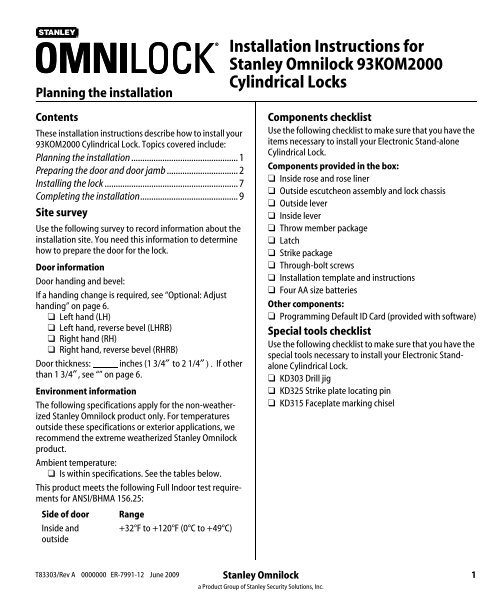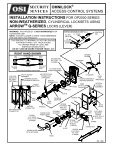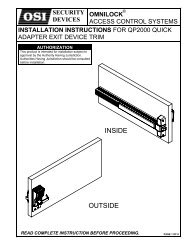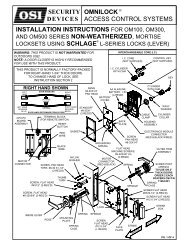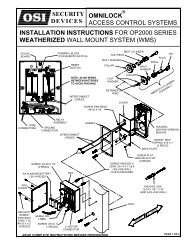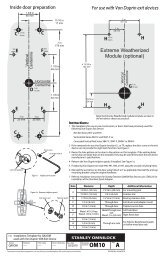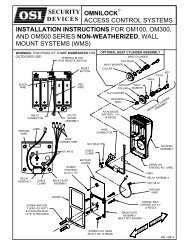Installation Instructions for Stanley Omnilock 9KOM Cylindrical Locks
Installation Instructions for Stanley Omnilock 9KOM Cylindrical Locks
Installation Instructions for Stanley Omnilock 9KOM Cylindrical Locks
You also want an ePaper? Increase the reach of your titles
YUMPU automatically turns print PDFs into web optimized ePapers that Google loves.
Planning the installation<br />
<strong>Installation</strong> <strong>Instructions</strong> <strong>for</strong><br />
<strong>Stanley</strong> <strong>Omnilock</strong> 93KOM2000<br />
<strong>Cylindrical</strong> <strong>Locks</strong><br />
Contents<br />
These installation instructions describe how to install your<br />
93KOM2000 <strong>Cylindrical</strong> Lock. Topics covered include:<br />
Planning the installation ................................................ 1<br />
Preparing the door and door jamb ................................ 2<br />
Installing the lock ............................................................ 7<br />
Completing the installation............................................ 9<br />
Site survey<br />
Use the following survey to record in<strong>for</strong>mation about the<br />
installation site. You need this in<strong>for</strong>mation to determine<br />
how to prepare the door <strong>for</strong> the lock.<br />
Door in<strong>for</strong>mation<br />
Door handing and bevel:<br />
If a handing change is required, see “Optional: Adjust<br />
handing” on page 6.<br />
❑ Left hand (LH)<br />
❑ Left hand, reverse bevel (LHRB)<br />
❑ Right hand (RH)<br />
❑ Right hand, reverse bevel (RHRB)<br />
Door thickness: inches (1 3/4″ to 2 1/4″). If other<br />
than 1 3/4″ , see “” on page 6.<br />
Environment in<strong>for</strong>mation<br />
The following specifications apply <strong>for</strong> the non-weatherized<br />
<strong>Stanley</strong> <strong>Omnilock</strong> product only. For temperatures<br />
outside these specifications or exterior applications, we<br />
recommend the extreme weatherized <strong>Stanley</strong> <strong>Omnilock</strong><br />
product.<br />
Ambient temperature:<br />
❑ Is within specifications. See the tables below.<br />
This product meets the following Full Indoor test requirements<br />
<strong>for</strong> ANSI/BHMA 156.25:<br />
Side of door<br />
Inside and<br />
outside<br />
Range<br />
+32°F to +120°F (0°C to +49°C)<br />
Components checklist<br />
Use the following checklist to make sure that you have the<br />
items necessary to install your Electronic Stand-alone<br />
<strong>Cylindrical</strong> Lock.<br />
Components provided in the box:<br />
❑ Inside rose and rose liner<br />
❑ Outside escutcheon assembly and lock chassis<br />
❑ Outside lever<br />
❑ Inside lever<br />
❑ Throw member package<br />
❑ Latch<br />
❑ Strike package<br />
❑ Through-bolt screws<br />
❑ <strong>Installation</strong> template and instructions<br />
❑ Four AA size batteries<br />
Other components:<br />
❑ Programming Default ID Card (provided with software)<br />
Special tools checklist<br />
Use the following checklist to make sure that you have the<br />
special tools necessary to install your Electronic Standalone<br />
<strong>Cylindrical</strong> Lock.<br />
❑ KD303 Drill jig<br />
❑ KD325 Strike plate locating pin<br />
❑ KD315 Faceplate marking chisel<br />
T83303/Rev A 0000000 ER-7991-12 June 2009<br />
<strong>Stanley</strong> <strong>Omnilock</strong><br />
a Product Group of <strong>Stanley</strong> Security Solutions, Inc.<br />
1
<strong>Installation</strong> <strong>Instructions</strong> <strong>for</strong> <strong>Stanley</strong> <strong>Omnilock</strong> 93KOM2000 <strong>Cylindrical</strong> <strong>Locks</strong><br />
Preparing the door and door jamb<br />
1 Position template and mark drill points<br />
High edge of<br />
door bevel<br />
Figure 1<br />
Positioning the template<br />
Template <strong>for</strong> 2 3/4" Backset<br />
6K, 7KC, 8K and 9K <strong>Cylindrical</strong> <strong>Locks</strong> with RQE<br />
Note: If the door is a fabricated hollow metal door,<br />
determine whether it is properly rein<strong>for</strong>ced to support<br />
the lock. If door rein<strong>for</strong>cement is not adequate, consult<br />
the door manufacturer <strong>for</strong> in<strong>for</strong>mation on proper rein<strong>for</strong>cement.<br />
For dimensions <strong>for</strong> preparing metal doors <strong>for</strong><br />
locks with 2 3/4” backset, see Template T56052 or<br />
T56053 Door and Frame Preparation <strong>for</strong> 63K, 73KC, 83K,<br />
and 93K <strong>Cylindrical</strong> <strong>Locks</strong>.<br />
Note: If the door is a LH or RH door, mark the inside of<br />
the door. If the door is a LHRB or RHRB door, mark the<br />
outside of the door.<br />
For uncut doors and frames<br />
1 Measure and mark the horizontal centerline of the<br />
lever (the centerline <strong>for</strong> the chassis hole) on the door<br />
and door jamb. Mark the vertical centerline of the door<br />
edge.<br />
Note: The recommended height from the floor to the<br />
centerline of the lock (centerline of 2 1/8” hole)<br />
is 40 5/16″ .<br />
2 Fold the template on the dashed line and carefully<br />
place it in position on the high side of the door bevel<br />
as shown in Figure 1.<br />
Note: For steel frame applications, align the template’s<br />
horizontal centerline <strong>for</strong> the latch with the horizontal<br />
centerline of the frame’s strike preparation.<br />
3 Tape the template to the door.<br />
4 Center punch the necessary drill points. Refer to the<br />
instructions on the template.<br />
For doors with standard cylindrical preparation<br />
1 Fold the template on the dashed line. Looking through<br />
the hole from the opposite side of the door, align the<br />
template so that you see the template outline of the<br />
2 1/8″ diameter chassis hole.<br />
2 Tape the template to the door.<br />
3 Center punch the necessary drill points. Refer to the<br />
instructions on the template.<br />
2<br />
<strong>Stanley</strong> <strong>Omnilock</strong><br />
a Product Group of <strong>Stanley</strong> Security Solutions, Inc.
<strong>Installation</strong> <strong>Instructions</strong> <strong>for</strong> <strong>Stanley</strong> <strong>Omnilock</strong> 93KOM2000 <strong>Cylindrical</strong> <strong>Locks</strong><br />
Preparing the door and door jamb<br />
<strong>Installation</strong> <strong>Instructions</strong> <strong>for</strong> <strong>Stanley</strong> <strong>Omnilock</strong> 93KOM2000 <strong>Cylindrical</strong> <strong>Locks</strong><br />
2 Drill holes and mortise <strong>for</strong> latch face<br />
1 Drill the holes listed below:<br />
■ motor wire hole<br />
◆ 7/16″ diameter<br />
◆ through door<br />
◆ be<strong>for</strong>e drilling chassis hole<br />
■ chassis hole<br />
◆ 2 1/8″ diameter<br />
◆ through door<br />
◆ after drilling motor wire hole<br />
■ latch hole<br />
◆ 1″ diameter<br />
◆ meets chassis hole<br />
■ anti-rotational hole, see “Use drill jig to drill<br />
through-bolt holes” on page 4.<br />
◆ 5/16” diameter<br />
◆ through door<br />
Note 1: To locate the center of a hole on the opposite<br />
side of the door, drill a pilot hole completely through the<br />
door.<br />
Note 2: For holes through the door, it is best to drill halfway<br />
from each side of the door to prevent the door from<br />
splintering.<br />
2 Mortise the edge of the door to fit the latch face.<br />
3 Drill the holes <strong>for</strong> the screws used to install the latch.<br />
3 Install latch<br />
1 Install the latch in the door as shown in Figure 3.<br />
Note: The latch tube prongs should be centered and<br />
should project into the chassis hole.<br />
2 Check that the door swings freely.<br />
Anti-rotational<br />
hole<br />
Latch hole<br />
Latch face<br />
mortise<br />
Figure 2<br />
Location of latch<br />
tube prongs<br />
Inside of door<br />
Chassis hole<br />
Motor wire hole<br />
Anti-rotational<br />
hole<br />
Drilling holes and mortising <strong>for</strong> the latch face<br />
Chassis hole<br />
Latch<br />
Inside of door<br />
Figure 3<br />
<strong>Stanley</strong> <strong>Omnilock</strong><br />
a Product Group of <strong>Stanley</strong> Security Solutions, Inc.<br />
Installing the latch in the door<br />
3
<strong>Installation</strong> <strong>Instructions</strong> <strong>for</strong> <strong>Stanley</strong> <strong>Omnilock</strong> 93KOM2000 <strong>Cylindrical</strong> <strong>Locks</strong><br />
Preparing the door and door jamb<br />
4 Use drill jig to drill through-bolt holes<br />
Drill upper through-bolt hole.<br />
1 Press the drill jig (KD303) onto the door, engaging it<br />
with the latch tube prongs (see the close-up in<br />
Figure 4). Make sure the front edge of the jig is parallel<br />
with the door edge.<br />
2 Drill the through-bolt holes (5/16″ diameter) halfway<br />
into the door.<br />
3 Turn over the drill jig and repeat steps 1 and 2 from the<br />
opposite side of the door.<br />
Note: Replace the drill jig after 10 door preparations.<br />
Latch<br />
tube<br />
prongs<br />
Figure 4<br />
Inside of door<br />
Drill lower through-bolt hole.<br />
Installing the drill jig and drilling the<br />
through-bolt holes<br />
4<br />
<strong>Stanley</strong> <strong>Omnilock</strong><br />
a Product Group of <strong>Stanley</strong> Security Solutions, Inc.
<strong>Installation</strong> <strong>Instructions</strong> <strong>for</strong> <strong>Stanley</strong> <strong>Omnilock</strong> 93KOM2000 <strong>Cylindrical</strong> <strong>Locks</strong><br />
Preparing the door and door jamb<br />
<strong>Installation</strong> <strong>Instructions</strong> <strong>for</strong> <strong>Stanley</strong> <strong>Omnilock</strong> 93KOM2000 <strong>Cylindrical</strong> <strong>Locks</strong><br />
5 Install strike box and strike plate<br />
1 In alignment with the center of the latchbolt, mortise<br />
the door jamb to fit the strike box and strike plate.<br />
2 Drill the holes <strong>for</strong> the screws used to install the strike<br />
box and strike plate.<br />
3 Insert the strike box and secure the strike with the two<br />
screws provided.<br />
4 Check the position of the deadlocking plunger against<br />
the strike plate.<br />
Caution: The deadlocking plunger of the latchbolt<br />
must make contact with the strike plate, as shown<br />
in Figure 6b. The plunger deadlocks the latchbolt<br />
and helps prevents someone from <strong>for</strong>cing the<br />
latch open when the door is closed.<br />
Strike box<br />
Strike plate<br />
Door jamb<br />
Figure 5a<br />
Installing the strike box and strike plate<br />
Deadlocking<br />
plunger<br />
Strike plate<br />
Door jamb<br />
Figure 6b<br />
Aligning the deadlocking plunger with the<br />
strike plate<br />
<strong>Stanley</strong> <strong>Omnilock</strong><br />
a Product Group of <strong>Stanley</strong> Security Solutions, Inc.<br />
5
<strong>Installation</strong> <strong>Instructions</strong> <strong>for</strong> <strong>Stanley</strong> <strong>Omnilock</strong> 93KOM2000 <strong>Cylindrical</strong> <strong>Locks</strong><br />
Preparing the door and door jamb<br />
2 1/4″ groove Through-<br />
2″<br />
bolt stud<br />
1 3/4″<br />
Hub face<br />
Outside<br />
rose liner<br />
Figure 7<br />
Battery cover<br />
Re-route wire<br />
Rotate chassis<br />
180 degrees<br />
clockwise<br />
Motor wire<br />
Rose locking pin<br />
Adjusting the rose liner <strong>for</strong> the door thickness<br />
Opening<br />
Rose<br />
6 Optional: Adjust <strong>for</strong> door thickness<br />
Note: The default door thickness is 1 3/4”. If your door<br />
application is thicker than 1 3/4”, use the following<br />
instructions.<br />
1 Determine the door’s thickness.<br />
2 Pull the rose locking pin and rotate the outside rose<br />
liner until the proper groove on the through-bolt stud<br />
lines up with the hub face. See Figure 7.<br />
7 Optional: Adjust handing<br />
This is only required if the lock hand does not meet your<br />
application. The lockset is normally preset <strong>for</strong> a right-hand<br />
door. Verify the hand of the lock and, if required, change<br />
the hand of the lock.<br />
1 In order: remove the gasket, battery cover, back plate.<br />
See Figure 8.<br />
2 Remove the chassis.<br />
3 Rotate the chassis 180 degrees clockwise (looking at<br />
the back or opposite the latch) so as not to pull the<br />
wire.<br />
4 Pry off the rose that holds the wire in place.<br />
5 Re-route the wire back through the opening<br />
in the rose.<br />
6 Press the rose back on.<br />
7 Reinstall the chassis.<br />
8 In order: reinstall back plate, battery cover, and gasket.<br />
Back plate<br />
Gasket<br />
Figure 8<br />
Adjusting the rose liner <strong>for</strong> the door thickness<br />
6<br />
<strong>Stanley</strong> <strong>Omnilock</strong><br />
a Product Group of <strong>Stanley</strong> Security Solutions, Inc.
Installing the lock<br />
<strong>Installation</strong> <strong>Instructions</strong> <strong>for</strong> <strong>Stanley</strong> <strong>Omnilock</strong> 93KOM2000 <strong>Cylindrical</strong> <strong>Locks</strong><br />
8 Install batteries<br />
Four alkaline AA batteries are furnished with your<br />
OMNILOCK system and must be installed be<strong>for</strong>e proceeding<br />
with operation verification and system installation.<br />
1 Remove the gasket from the rear of the housing<br />
assembly as shown in Figure 9.<br />
2 Remove the screw from the battery cover and remove<br />
the cover.<br />
3 Install batteries with proper polarity as shown<br />
in Figure 9.<br />
4 Press and hold the reset button as shown in Figure 10<br />
on the PC board until the green light on the keypad<br />
flashes (about three seconds) then release the button.<br />
5 Replace the battery cover. See Figure 9. Make sure that<br />
the tabs on the lower edge of the battery cover are<br />
hooked over the edge of the back plate and secure the<br />
cover with the screw.<br />
6 Replace the gasket. See Figure 9. Make sure that it is<br />
inside the edge of the housing.<br />
Check operation<br />
1 Press 1234<br />
The green light will flash once and unlock.<br />
2 Turn the lever and open the door.<br />
During the unlock time, the green light flashes three<br />
times. Then the lock flashes red and relocks.<br />
3 If your system has a magnetic card reader, verify<br />
proper operation of the system using the magnetic<br />
card reader; otherwise, see “Test lock” on page 10.<br />
4 A label on the housing assembly battery cover indicates<br />
the magnetic card track, (track 2 or track 3) that<br />
the system is set to read. See Figure 9.<br />
Housing assembly<br />
Track setting<br />
label<br />
SEMS #4-<br />
40 x 1/4”<br />
Pan head<br />
Figure 9<br />
Figure 10<br />
Installing batteries<br />
AA Batteries<br />
Back plate<br />
Battery cover<br />
Gasket<br />
Using the reset button<br />
Terminal block<br />
Reset button<br />
Motor connector<br />
Red wire<br />
Black wire<br />
<strong>Stanley</strong> <strong>Omnilock</strong><br />
a Product Group of <strong>Stanley</strong> Security Solutions, Inc.<br />
7
<strong>Installation</strong> <strong>Instructions</strong> <strong>for</strong> <strong>Stanley</strong> <strong>Omnilock</strong> 93KOM2000 <strong>Cylindrical</strong> <strong>Locks</strong><br />
Installing the lock<br />
Outside escutcheon<br />
and chassis<br />
9 Install outside escutcheon and lock<br />
chassis and engage retractor in latch<br />
1 From the outside of the door, insert the lock chassis<br />
and outside escutcheon into the 2 1/8″ chassis hole.<br />
See Figure 11.<br />
2 Make sure that the latch tube prongs engage the chassis<br />
frame and that the latch tailpiece engages the<br />
retractor. See Figure 12.<br />
Inside of door<br />
Figure 11<br />
Installing the outside escutcheon and lock<br />
chassis<br />
Retractor<br />
Latch tube<br />
prong<br />
Latch<br />
tailpiece<br />
Latch tube<br />
prong<br />
Chassis frame<br />
Notch<br />
Chassis<br />
Figure 12<br />
8<br />
Inside of door<br />
Installing the lock chassis and engaging the<br />
retractor in the latch<br />
<strong>Stanley</strong> <strong>Omnilock</strong><br />
a Product Group of <strong>Stanley</strong> Security Solutions, Inc.
<strong>Installation</strong> <strong>Instructions</strong> <strong>for</strong> <strong>Stanley</strong> <strong>Omnilock</strong> 93KOM2000 <strong>Cylindrical</strong> <strong>Locks</strong><br />
Completing the installation<br />
<strong>Installation</strong> <strong>Instructions</strong> <strong>for</strong> <strong>Stanley</strong> <strong>Omnilock</strong> 93KOM2000 <strong>Cylindrical</strong> <strong>Locks</strong><br />
10 Install through-bolts, inside<br />
rose and lever<br />
1 Place the inside rose liner on the chassis, aligning the<br />
holes in the rose liner with the holes prepared in the<br />
door as shown in Figure 13.<br />
2 Install the through-bolts through the rose liner and<br />
door in the top and bottom holes.<br />
3 Tighten the rose liner on the door with the<br />
through-bolts.<br />
4 Install the inside rose onto the rose liner.<br />
5 Install the inside lever.<br />
11 Install outside lever, core and throw<br />
member<br />
For a non-IC lever handle<br />
1 Place the cylinder inside the outside lever.<br />
See Figure 14.<br />
2 Install the retainer into the outside lever.<br />
3 Insert the key into the cylinder and rotate the key 90<br />
degrees clockwise. Slide the lever assembly onto the<br />
spindle until it stops against the lever catch.<br />
4 Push the lever into place until the lever catch is<br />
engaged. Pull on the lever to make sure the lever catch<br />
is engaged. Turn the key back to the normal position<br />
and remove it from the cylinder.<br />
For interchangeable core handles<br />
1 Press the outside lever onto the spindle until the lever<br />
catch is engaged.<br />
2 Install the blocking plate onto the throw member.<br />
Caution: You must use the blocking plate to prevent<br />
unauthorized access.<br />
For 6-pin core users only: Install the plastic spacer<br />
(not shown, supplied with permanent cores) instead of<br />
the blocking plate, on the throw member.<br />
3 Insert the control key into the core and rotate the key<br />
15 degrees to the right.<br />
4 Insert the throw member into the core.<br />
Rose liner<br />
Through-bolt<br />
Chassis<br />
Figure 13<br />
Figure 14<br />
Inside rose<br />
Inside of<br />
door<br />
Installing the through-bolts and rose liner<br />
Key<br />
Installing outside lever, both non-IC<br />
and IC levers shown<br />
Outside lever<br />
Push pin<br />
Cylinder<br />
Retainer<br />
<strong>Stanley</strong> <strong>Omnilock</strong><br />
a Product Group of <strong>Stanley</strong> Security Solutions, Inc.<br />
9
<strong>Installation</strong> <strong>Instructions</strong> <strong>for</strong> <strong>Stanley</strong> <strong>Omnilock</strong> 93KOM2000 <strong>Cylindrical</strong> <strong>Locks</strong><br />
Completing the installation<br />
5 Insert the core and throw member into the lever with<br />
the control key.<br />
6 Rotate the control key 15 degrees to the left and withdraw<br />
the key.<br />
Caution: The control key can be used to remove<br />
cores and to access doors. Provide adequate security<br />
<strong>for</strong> the control key.<br />
12 Test lock<br />
For <strong>9KOM</strong>2000 <strong>Locks</strong>:<br />
To test the lock <strong>for</strong> proper operation be<strong>for</strong>e the lock is programmed,<br />
follow these instructions:<br />
For keypad locks<br />
1 Press 1234<br />
The green light will flash once and unlock.<br />
2 Turn the lever and open the door.<br />
During the unlock time, the green light flashes three<br />
times. Then the lock flashes red and relocks.<br />
For magnetic stripe or proximity card only locks<br />
Note: If the lock has a proximity card reader, it may have<br />
already been activated by the presence of an object near<br />
the card reader.<br />
1 Align the magnetic stripe card with the V mark by the<br />
card slot.<br />
2 Insert and then remove the card.<br />
The green light flashes once and unlocks.<br />
3 Turn the lever and open the door.<br />
During the unlock time, if using the Programming<br />
Default ID Card, the green light flashes three times. Then<br />
the lock flashes red and relocks.<br />
Troubleshooting<br />
If the mechanism doesn’t unlock, remove the battery<br />
cover and check <strong>for</strong> proper orientation and seating of the<br />
batteries or motor connector. Ensure that wires are not<br />
pinched. Reset the electronics by pressing and holding<br />
the reset button on the circuit board until the light flashes<br />
green (approx three seconds), then release. See Figure 10.<br />
The system will go through a self-test and flash green<br />
five times. You will hear the lock unlock, then relock three<br />
times. A red flash indicates a PC board or drive system<br />
problem. If a red flash or no flash is observed, check <strong>for</strong><br />
proper orientation and seating of the batteries and<br />
motor connector, ensure that wires are not pinched and<br />
then repeat the reset process.<br />
Removing the levers (when needed)<br />
Use this procedure only when needed.<br />
Removing the IC outside lever<br />
1 Insert the control key into the core and rotate the key<br />
15 degrees to the right.<br />
2 Remove the core and throw member from the lever.<br />
3 Insert a flat blade screwdriver into the figure-8 core<br />
hole and into the lever keeper.<br />
4 Press the screwdriver blade in the direction of the<br />
arrow in Figure 16.<br />
Figure 16<br />
Pressing the lever keeper to remove the lever<br />
Note: You will not be able to remove the lever if the<br />
screwdriver blade is inserted too far past the keeper.<br />
5 Slide the lever off of the sleeve.<br />
10<br />
<strong>Stanley</strong> <strong>Omnilock</strong><br />
a Product Group of <strong>Stanley</strong> Security Solutions, Inc.
Completing the installation<br />
Removing the non-IC outside lever<br />
1 Insert the key into the cylinder and turn it 45 degrees<br />
clockwise.<br />
2 Depress the lever catch through the hole in the outside<br />
lever by using the push pin or another suitable tool.<br />
See Figure 17.<br />
3 Slide the outside lever off.<br />
<strong>Installation</strong> <strong>Instructions</strong> <strong>for</strong> <strong>Stanley</strong> <strong>Omnilock</strong> 93KOM2000 <strong>Cylindrical</strong> <strong>Locks</strong><br />
Turn key 45<br />
degrees<br />
clockwise<br />
Outside lever<br />
Push pin<br />
Figure 17<br />
Removing the outside non-IC lever<br />
Removing the inside lever<br />
1 Depress the lever catch through the hole in the inside<br />
lever by using the push pin or another suitable tool as<br />
shown in Figure 18.<br />
2 Slide the outside lever off.<br />
Inside lever<br />
Push pin<br />
Figure 18<br />
Removing the inside lever<br />
<strong>Stanley</strong> <strong>Omnilock</strong><br />
a Product Group of <strong>Stanley</strong> Security Solutions, Inc.<br />
11
12<br />
<strong>Stanley</strong> <strong>Omnilock</strong><br />
a Product Group of <strong>Stanley</strong> Security Solutions, Inc.


